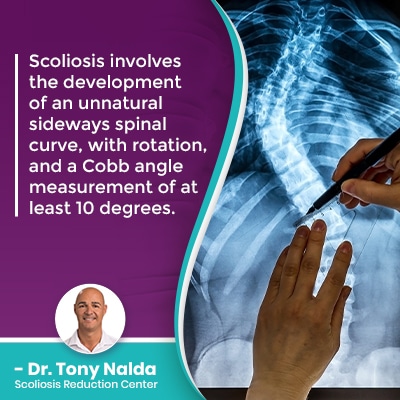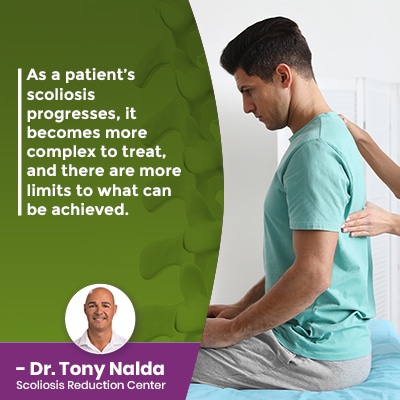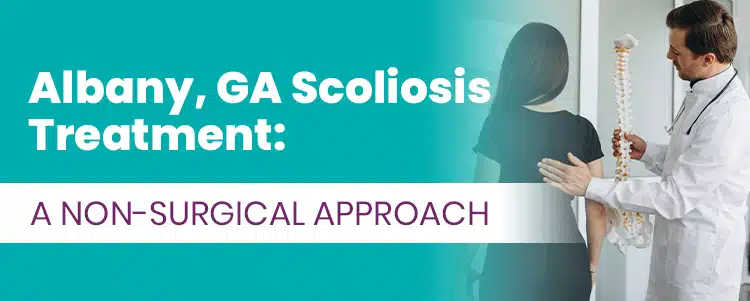Scoliosis is a complex spinal condition that ranges widely in severity, has different types, and affects all ages. After receiving a diagnosis of scoliosis, the most important decision patients have to make is how to address it moving forward; different treatment approaches offer different potential results.
Residents of Albany, GA are fortunate to be only a 5-hour drive from world-class non-surgical scoliosis treatment in Celebration, Florida: home to Dr. Tony Nalda’s Scoliosis Reduction Center®, where results prove that not all cases of scoliosis require surgery.
There are two main scoliosis treatment approaches to discuss, but let’s first talk about how scoliosis is diagnosed.
How is Scoliosis Diagnosed?
As the leading spinal condition amongst school-aged children, there was a time when mandatory scoliosis screening was conducted in schools across the United States, but that has since changed, shifting the onus of early detection onto the shoulders of patients and their families.
While scoliosis affects all ages, it is most prevalent in children, and particularly in mild cases, the condition’s early signs can be subtle and difficult for anyone, other than a scoliosis specialist, to notice.
In children, the main scoliosis symptom is postural deviation due to the condition’s uneven forces disrupting the body’s overall symmetry, and the main symptom of scoliosis in adults is pain; this is because scoliosis doesn’t become a compressive condition until adulthood.
Being diagnosed with scoliosis involves a comprehensive physical examination and X-ray imaging to really see what’s happening in and around the spine.

Scoliosis involves the development of an unnatural sideways spinal curve, with rotation, and a Cobb angle measurement of at least 10 degrees.
A patient’s Cobb angle is known as the gold standard in the diagnosis/assessment of scoliosis and is determined during X-ray by drawing lines from the tops and bottoms of the curve’s most-tilted vertebrae, at its apex; the intersecting lines form an angle that’s expressed in degrees.
The Cobb angle tells me how far out of alignment the spine is and classifies conditions based on severity:
- Mild scoliosis: Cobb angle measurement of between 10 and 25 degrees
- Moderate scoliosis: Cobb angle measurement of between 25 and 40 degrees
- Severe scoliosis: Cobb angle measurement of 40+ degrees
- Very-severe scoliosis: Cobb angle measurement of 80+ degrees
It’s important to understand that as a progressive condition, where a person’s scoliosis is at the time of diagnosis is not indicative of where it will stay, at least not without the help of proactive treatment.
Proactive Treatment and Progression
As a progressive condition, scoliosis has it in its nature to worsen over time, and this means the size of the scoliotic curve is going to increase, as are the condition’s uneven forces and their effects.

As a patient’s scoliosis progresses, it becomes more complex to treat, and there are more limits to what can be achieved.
While there are no treatment guarantees, early detection and intervention have a number of treatment benefits, which is why applying proactive treatment as soon as possible is so important.
As mentioned, there are two main scoliosis treatment approaches, so let’s explore traditional and conservative treatment, and the potential results of each.
Traditional Scoliosis Treatment
Traditional scoliosis treatment was the dominant choice for many years, but that doesn’t mean it was the best, or only, treatment option available.
Remember, scoliosis that’s diagnosed early in the condition’s progressive line, when responded to with proactive treatment, can be highly treatable, but what about an approach that recommends watching and waiting?
Traditional treatment doesn’t have a strategy for treating scoliosis proactively, or while mild, so does little to work towards preventing progression; it commonly recommends that once a patient’s scoliosis becomes severe, surgery is the best remaining treatment option.
Scoliosis surgery, also known as spinal fusion, involves fusing the curve’s most-tilted vertebrae into one solid bone, and this is done because the main goal of traditional treatment isn’t to correct a scoliosis, but to stop progression; stopping progression isn’t the same as correcting a scoliosis.
Once the vertebrae at the curve’s apex are fused, rods are commonly attached to the spine with screws to hold it in place, and the hardware attached is permanent.
A fused spine is contrary to its movement-based design, making it weaker and more vulnerable to injury, and in many cases, there is a noticeable loss of spinal flexibility and range of motion.
Conservative Scoliosis Treatment
Conservative treatment, also known as functional and/or chiropractic-centered, is a modern approach that strives to preserve as much of the spine’s natural strength and function as possible, while avoiding the need for invasive spinal surgery.
Here at the Scoliosis Reduction Center®, a proactive conservative treatment approach is only a 5-hour drive, across 315 miles, away for residents of Albany, GA.
The Center’s results speak for themselves as numerous patients have experienced significant curvature reductions and corrective results that have stood the test of time.
By being trained and certified in multiple treatment modalities, Dr. Tony’s patients benefit from accessing multiple forms of treatment under one roof.
With a diagnosis of mild scoliosis, and all severity levels, I want to start treatment as close to the time of diagnosis as possible.
Treating scoliosis is simpler when mild; the unnatural spinal curve is at its smallest, the spine is going to be at its most flexible and responsive to treatment, and the condition’s effects are also going to be mild.
Regardless of condition severity, however, the best time to start scoliosis treatment is always now, as is the case with most progressive conditions.
I integrate condition-specific chiropractic care, in-office therapy, corrective bracing, and rehabilitation into customized treatment plans so conditions can be impacted on every level.
Chiropractic Care
As a structural condition, scoliosis has to be, first and foremost, impacted on a structural level, and this involves reducing the scoliotic curve.
A series of chiropractic techniques and manual adjustments can work towards repositioning the curve’s most-tilted vertebrae so they are more aligned with the rest of the spine, and as much of the spine’s healthy curves as possible are restored.
I order periodic X-rays to monitor how the spine is responding to treatment and adjust treatment plans accordingly.
In-Office Therapy
In-office therapy can involve a number of therapies including physical therapy that uses a number of therapeutic exercises and stretches.
It’s not just the spine that has to maintain its natural curves and alignment; the spine’s surrounding muscles are also tasked with supporting and stabilizing it.
Increasing the spine’s surrounding muscle strength means it’s being optimally supported, and this takes pressure off the spine and its individual structures.
Physical therapy can also address any related muscle imbalance; an unnaturally-curved spine can pull its surrounding muscles in different directions, causing one side to become stretched and loose from overuse, and the other side’s muscles to become weak from underuse.
In addition, certain condition-specific exercises and stretches can also help with postural remodeling and improved brain-body communication.
Corrective Bracing
Corrective bracing can be a particularly helpful facet of treatment on patients who are still growing so is commonly used when treating the condition’s most common type: adolescent idiopathic scoliosis, diagnosed between the ages of 10 and 18.
An ultra-corrective ScoliBrace can help augment results achieved through other forms of treatment by pushing the spine into a corrective position.
No brace is effective enough to correct a scoliosis on its own, but when combined with other forms of proactive treatment, it can increase treatment efficacy.
Rehabilitation
Although scoliosis is incurable, it can be highly treatable, but some efforts need to be made to sustain treatment results long term.
A series of custom-prescribed exercises can help patients establish a home-rehabilitation program to further stabilize the spine.
Conclusion
Those in search of Albany, GA scoliosis treatment are only a 5-hour drive, and approximately 315 miles, away from Celebration, Florida: home to the esteemed scoliosis chiropractor, Dr. Tony Nalda, and his Scoliosis Reduction Center®.
The Center provides patients with an alternative to invasive and costly spinal surgery by offering a modern conservative treatment approach that combines multiple forms of non-surgical treatment.
By integrating different types of treatment into treatment plans, conditions are impacted on every level, and as the complex nature of scoliosis necessitates a customized treatment approach, this allows me to apportion each discipline accordingly, based on how the spine is responding to treatment.
Through chiropractic care, conditions are impacted on a structural level, while physical therapy works towards increasing core strength for optimal spinal support; corrective bracing can complement other forms of treatment, and guidance on establishing a home-rehabilitation program helps to further heal the spine.
Scoliosis can be a confusing and overwhelming condition to be diagnosed with, but the good news is that when responded to proactively, it can be highly treatable.
Don’t hesitate to reach out for guidance and support that can lead to treatment capable of helping scoliosis-patients thrive, despite being diagnosed with a progressive spinal condition.




